 |
Focus features two in-depth reviews each month of fine art, architecture and design exhibitions and events at art museums, galleries and alternative spaces around Japan. The contributors are non-Japanese art critics living in Japan. |
|
|
 |
 |
 |
Ken Nakazawa: Four Lines in Painted Steel
Nicolai Kruger |
 |
 |
|
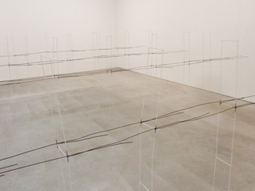 |
| Ken Nakazawa's wispy assemblage Four Lines fades into one wall of Ando Gallery. |
|
From certain angles, the extent of Four Lines is unclear, causing visitors to carefully consider their movements. |
Just a short walk from the Museum of Contemporary Art Tokyo (MOT), between the Kiba and Kiyosumi Shirakawa metro stations in Koto-ku, is a hidden gem, Ando Gallery. Set discreetly back from the street, this two-room exhibit space was founded by the art and design coordinator Koichi Ando in 1984. The gallery features foreign and Japanese artists whose work tends to be serial in nature. One of these is painter and installation artist Ken Nakazawa, whose work is on display until late April.
A graduate from the Department of Oil Painting at Tama Art University, Nakazawa completed his postgraduate course in 1994. Since then the Tokyo native has continued to paint, but at some point he began to delve into installation work, perhaps as a break from the two-dimensional medium. Recently he has received high praise for his installations and has participated in solo and group shows, including exhibitions at MOT and the Yokohama Triennale. Nakazawa's installations are fabricated in situ and in correspondence with the surroundings of the display space. Special attention is paid to spatial and formalistic qualities. While his installations are made of thin, wispy materials such as wire, the way these are applied repeatedly, in layers, means the resulting effect is often referential to his painting work, with a cubist or constructivist appeal.
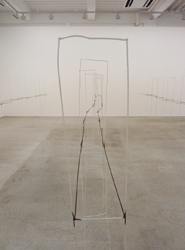 |
|
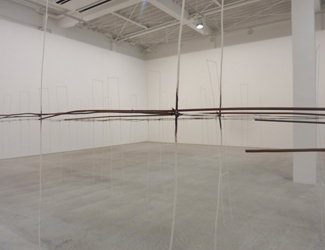 |
| Looking straight on at one set of the thin wire frames, a painterly composition emerges. |
|
A close-up of the steel wire cross-supports left unpainted. |
Four Lines is Nakazawa's fourth solo show at Ando Gallery and the first installation he has presented in three years. This large-scale piece fills the entire gallery exhibit space. It is composed of four rows of slightly distorted rectangular frames made of painted steel wire that project outward from one gallery wall. Horizontal rods, rusted and unpainted, are suspended between these frames, tying each of the four lines together. Because the vertical elements are painted white, they nearly disappear against the gallery walls, creating the illusion that the horizontal rods are floating within the space. The trick is deceptively simple but effective enough to leave viewers wondering what holds it all up. While the medium is not specifically found-object, it is reminiscent of barbed-wire fencing.
With Four Lines, Nakazawa does not depict a form but rather makes concrete nuances within a space. Moving about the installation reveals a rhythm, like that of tall grass blowing in the wind. Simultaneously pulled toward the detail yet constantly aware of the overall composition, one has a heightened sense of the fragility of the piece. Because one wrong move might bring the whole installation down, the viewer proceeds carefully, so as not to trip on a wire. When Four Lines is viewed from different angles a range of compositional effects emerges, from jarring to tranquil and back again. How to interpret this abstraction is left to the visitor.
 |
|
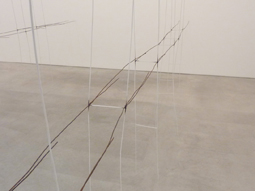 |
| Ken Nakazawa's deceptively simple assembly detail. |
|
The horizontal wire cross-supports hover over the floor and die into the wall of Ando Gallery.
|
Part of the beauty of Nakazawa's melancholic installation is in what it is not: conceptual or representational. An ode to nothing -- is this itself a commentary, or is it just a spatial illusion? In a 2001 interview Nakazawa said of his approach to installation art, "The part that cannot be seen, that is difficult to see, shows the space in which it is placed as such. It does not fill the space with a limited image but suggests the site by not being limiting. I do not show that 'this is a particular thing.' Rather I want to ask a quite vague question, 'this may be something, but what is it?'" (From an interview with Ken Nakazawa by Koichi Ando in New Blood: Art, Architecture and Design in Japan, Rikuyosha, 2001)
Nakazawa's work to date and his own words suggest that he is still asking the question and still testing the genre.
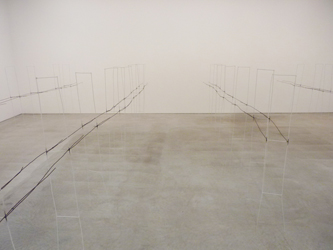 |
|
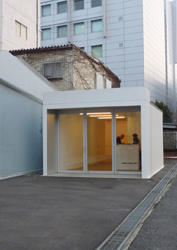 |
| In Nakazawa's own words, "This may be something, but what is it?" |
|
A hidden gem, Ando Gallery is set discreetly back from the street.
All photographs by Nicolai Kruger with permission of Ando Gallery.
|
|
|
|
 |
Ken Nakazawa Exhibition |
 |
Ando Gallery |
 |
7 February - 28 April 2012 |
 |
|
|
|
|
 |
 |
Nicolai Kruger, AIA
Nicolai Kruger is an architect managing international projects at Pelli Clarke Pelli Architects, Japan. She has been living in Tokyo since 2006. She received her BFA in Design at Cornish College of the Arts in Seattle, followed by her Masters of Architecture at the University of Oregon. Her principal areas of interest include mixed-use, temporary structures, exhibition and lighting design. |
|
 |
|